
Hannes Bok, pseudonym for Wayne Francis Woodard, was an American artist and illustrator, as well as an amateur astrologer and writer of fantasy fiction and poetry. He painted nearly 150 covers for various science fiction, fantasy, and detective fiction magazines, as well as contributing hundreds of black and white interior illustrations. Bok's work graced the pages of calendars and early fanzines, as well as dust jackets from specialty book publishers like Arkham House, Llewellyn, Shasta Publishers, and Fantasy Press. His paintings achieved a luminous quality through the use of an arduous glazing process, which was learned from his mentor, Maxfield Parrish. Bok shared one of the inaugural 1953 Hugo Awards for science fiction achievement.

Damon Francis Knight was an American science fiction author, editor, and critic. He is the author of "To Serve Man", a 1950 short story adapted for The Twilight Zone. He was married to fellow writer Kate Wilhelm.

Dangerous Visions is an anthology of science fiction short stories edited by American writer Harlan Ellison and illustrated by Leo and Diane Dillon. It was published in 1967 and contained 33 stories, none of which had been previously published.

Edmund Alexander Emshwiller was an American visual artist notable for his science fiction illustrations and his pioneering experimental films. He usually signed his illustrations as Emsh but sometimes used Ed Emsh, Ed Emsler, Willer and others.
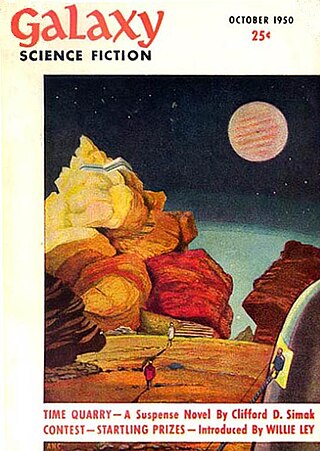
Galaxy Science Fiction was an American digest-size science fiction magazine, published in Boston from 1950 to 1980. It was founded by a French-Italian company, World Editions, which was looking to break into the American market. World Editions hired as editor H. L. Gold, who rapidly made Galaxy the leading science fiction magazine of its time, focusing on stories about social issues rather than technology.

Daniel Francis Galouye was an American science fiction writer. During the 1950s and 1960s, he contributed novelettes and short stories to various digest size science fiction magazines, sometimes writing under the pseudonym Louis G. Daniels.

The Magazine of Fantasy & Science Fiction is a U.S. fantasy and science fiction magazine, first published in 1949 by Mystery House, a subsidiary of Lawrence Spivak's Mercury Press. Editors Anthony Boucher and J. Francis McComas had approached Spivak in the mid-1940s about creating a fantasy companion to Spivak's existing mystery title, Ellery Queen's Mystery Magazine. The first issue was titled The Magazine of Fantasy, but the decision was quickly made to include science fiction as well as fantasy, and the title was changed correspondingly with the second issue. F&SF was quite different in presentation from the existing science fiction magazines of the day, most of which were in pulp format: it had no interior illustrations, no letter column, and text in a single-column format, which in the opinion of science fiction historian Mike Ashley "set F&SF apart, giving it the air and authority of a superior magazine".
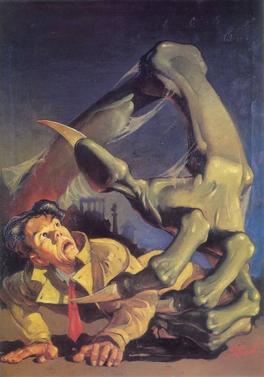
Edward Daniel Cartier, known professionally as Edd Cartier, was an American pulp magazine illustrator who specialized in science fiction and fantasy art.

Virgil Finlay was an American pulp fantasy, science fiction and horror illustrator. He has been called "part of the pulp magazine history ... one of the foremost contributors of original and imaginative art work for the most memorable science fiction and fantasy publications of our time." While he worked in a range of media, from gouache to oils, Finlay specialized in, and became famous for, detailed pen-and-ink drawings accomplished with abundant stippling, cross-hatching, and scratchboard techniques. Despite the very labor-intensive and time-consuming nature of his specialty, Finlay created more than 2600 works of graphic art in his 35-year career.

Richard Bassford is an American illustrator who has worked in both advertising and comic books.

Tales from Gavagan's Bar is a collection of fantasy short stories by American writers L. Sprague de Camp and Fletcher Pratt, illustrated by the latter's wife Inga Pratt. It was first published in hardcover by Twayne Publishers in 1953; an expanded edition rearranging the contents and adding pieces not in the first was published in hardcover by Owlswick Press in June 1978. The original illustrations were retained in this edition. It was subsequently issued in paperback by Bantam Books in January 1980. An e-book edition was published by Gollancz's SF Gateway imprint on September 29, 2011 as part of a general release of de Camp's works in electronic form. The collection has also been published in German.
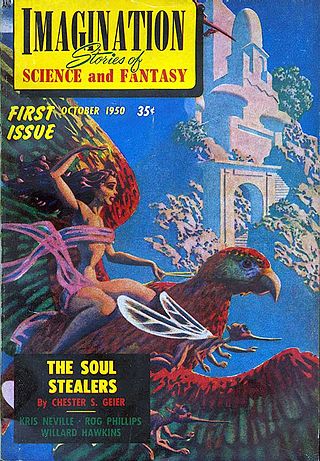
Imagination was an American fantasy and science fiction magazine first published in October 1950 by Raymond Palmer's Clark Publishing Company. The magazine was sold almost immediately to Greenleaf Publishing Company, owned by William Hamling, who published and edited it from the third issue, February 1951, for the rest of the magazine's life. Hamling launched a sister magazine, Imaginative Tales, in 1954; both ceased publication at the end of 1958 in the aftermath of major changes in US magazine distribution due to the liquidation of American News Company.

Beyond Fantasy Fiction was a US fantasy fiction magazine edited by H. L. Gold, with only ten issues published from 1953 to 1955. The last two issues carried the cover title of Beyond Fiction, but the publication's name for copyright purposes remained as before.
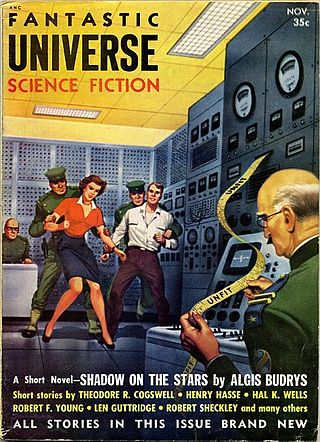
Fantastic Universe was a U.S. science fiction magazine which began publishing in the 1950s. It ran for 69 issues, from June 1953 to March 1960, under two different publishers. It was part of the explosion of science fiction magazine publishing in the 1950s in the United States, and was moderately successful, outlasting almost all of its competitors. The main editors were Leo Margulies (1954–1956) and Hans Stefan Santesson (1956–1960); under Santesson's tenure the quality declined somewhat, and the magazine became known for printing much UFO-related material. A collection of stories from the magazine, edited by Santesson, appeared in 1960 from Prentice-Hall, titled The Fantastic Universe Omnibus.
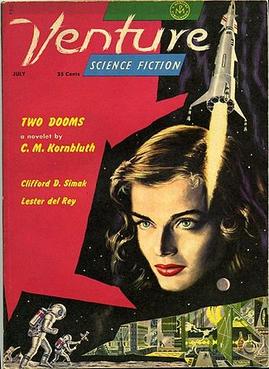
Venture Science Fiction was an American digest-size science fiction magazine, first published from 1957 to 1958, and revived for a brief run in 1969 and 1970. Ten issues were published of the 1950s version, with another six in the second run. It was founded in both instances as a companion to The Magazine of Fantasy & Science Fiction. Robert P. Mills edited the 1950s version, and Edward L. Ferman was editor during the second run. A British edition appeared for 28 issues between 1963 and 1965; it reprinted material from The Magazine of Fantasy & Science Fiction as well as from the US edition of Venture. There was also an Australian edition, which was identical to the British version but dated two months later.
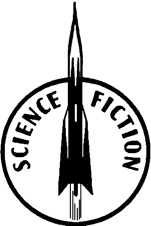
Winston Science Fiction was a series of 37 American juvenile science fiction books published by the John C. Winston Company of Philadelphia from 1952 to 1960 and by its successor Holt, Rinehart & Winston in 1960 and 1961. It included 35 novels by various writers, including many who became famous in the SF field, such as Poul Anderson, Arthur C. Clarke, Ben Bova, and Lester del Rey. There was also one anthology, The Year After Tomorrow, edited by del Rey and others. There was one non-fiction book Rockets Through Space: The Story of Man's Preparations to Explore the Universe by del Rey which details the factual science and technology of rocket flight. Many of the dust jackets became science fiction classics; the artists included Hugo Award winners Ed Emshwiller and Virgil Finlay along with Hugo nominees such as Mel Hunter and Alex Schomburg.

Portals of Tomorrow is an anthology of science fiction stories edited by American writer August Derleth, intended as the first in a series of "year's best" volumes. It was first published by Rinehart & Company in 1954. The stories had originally appeared in the magazines Fantasy and Science Fiction, Future, Esquire, Fantastic Universe, Galaxy Science Fiction, Blue Book, Startling Stories, Orbit, Astounding Stories and Beyond Fantasy Fiction.

"The Builder" is a science fiction short story by American writer Philip K. Dick. It was first published in the magazine Amazing Stories, in December, 1953-January 1954, with illustration by Ed Emshwiller. Dick had submitted many short stories to magazines and made approximately fifteen sales before becoming a client of the Scott Meredith Literary Agency. This was his first SMLA submission, received by SMLA on July 23, 1952. His second SMLA submission was Meddler, received by SMLA on July 24, 1952. The SMLA file card for "The Builder" shows it was submitted to mainstream magazines The Atlantic Monthly and Harper's before it was submitted to Amazing Stories and has an SMLA sub-agent's notation, "IT ISN'T SCIENCE FICTION".

Out of This World Adventures was an American pulp magazine which published two issues, in July and December 1950. It included several pages of comics as well as science fiction stories. It was edited by Donald A. Wollheim and published by Avon. Sales were weak, and after two issues Avon decided to cancel it.

Between 1952 and 1954, John Raymond published four digest-size science fiction and fantasy magazines. Raymond was an American publisher of men's magazines who knew little about science fiction, but the field's rapid growth and a distributor's recommendation prompted him to pursue the genre. Raymond consulted and then hired Lester del Rey to edit the first magazine, Space Science Fiction, which appeared in May 1952. Following a second distributor's suggestion that year, Raymond launched Science Fiction Adventures, which del Rey again edited, but under an alias. In 1953, Raymond gave del Rey two more magazines to edit: Rocket Stories, which targeted a younger audience, and Fantasy Magazine, which published fantasy rather than science fiction.



















